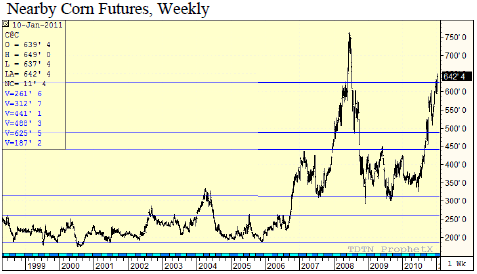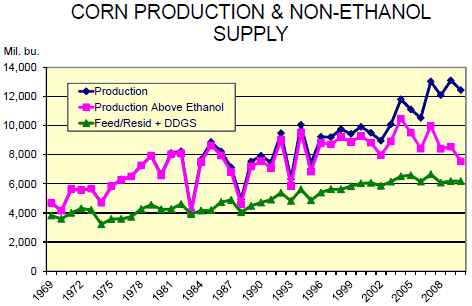



CME: Significance of Latest USDA Reports for Corn
US - "How significant was yesterday’s USDA reports and the resulting two-day move for corn futures?" ask Steve Meyer and Len Steiner.We think pretty significant in that the rally took out the last semblance of resistance on the monthly chart short of the all-time highs back in June 2008. Today’s close of $6.42 on the nearby March contract is the highest ever outside of the six weeks from 2 June through 7 July 2008. The only remaining resistance would be at the all-time high of $7.50/bushel. While it may be unlikely, things could indeed get worse for livestock and poultry feeders.

The old adage goes that “We will never run out of [fill in your favorite grain here]. It may get very expensive but we will never run out.” We still believe that to be true in the long run and on a national scope but we are beginning to have a few doubts about the universal applicability of the statement.
With USDA”s new projection for year-end 2011 stocks at 725 million bushels, its second lowest in bushels since 1976 and second lowest EVER relative to total usage, one has to consider just how long that stock could last. That answer is LESS THAN THREE WEEKS and remember that that 3-week supply will be scattered all over the country. We still agree that the America will not run out of corn but it is pretty likely that some Americans will run out of corn or have a tough time finding it in a timely manner come August and September. A delayed harvest would not be a good thing.
The continued growth of ethanol production has driven the supply of corn available for all other uses to 7.547 billion bushels, its lowest level since 1995. USDA has feed usage pegged at 5.2 billion bushels as of yesterday but we believe that number could go lower as livestock and poultry feeders respond by lowering weights and reducing numbers where possible. If it drops by 33 million bushels, this number, too, will be at its lowest level since 1995.

Distillers dried grains (DDGs), the major by-product of ethanol production, do add to the feed supply available to livestock and poultry feeders. But even that feed source is growing much slower due to rapidly rising exports. US ethanol manufacturers exported only 1.07 million metric tons of DDGs in 2005. Exports in 2010, based on January-November data will be over 9.15 million metric tons. Those shipments will remove the equivalent of roughly 350 million bushels of corn from the US feed supply. The result is 2010-2011 domestic corn and DDGs availability to livestock and poultry feeders that is roughly even with 2010 and a continuation of a slightly downward trend that dates back to 2005.
It is surprising how many people ask us “Why don’t they just substitute something else for corn?” That seems a logical question until one considers that the available supply of most other grains is falling as well. This year’s sorghum (milo) crop is 59 million bushels smaller than last year and projected feed usage is 30 million bushels lower. Barley output is down 47 million bushels and feed usage is down 3 million (since there are MUCH more important uses of barley — or so we are told). Oat output is 12 million bushels lower with no change in feed availability. Only wheat is projected to see higher feed usage this year (20 million bushels) but that will occur in areas such as the Southwest and Northwest that have relatively weak wheat and strong corn basises. Further, every other “alternative feed ingredient” such as milling by-products, stale bread, broken cookies, off-spec pet foods, crushed corn or potato chips, etc. etc. etc. a) were all being used by somebody before feed prices rose and b) are generally priced off the value of corn and are thus more expensive, too. There will be little in any feed available for higher meat, milk and egg production this year and, likely, next.









